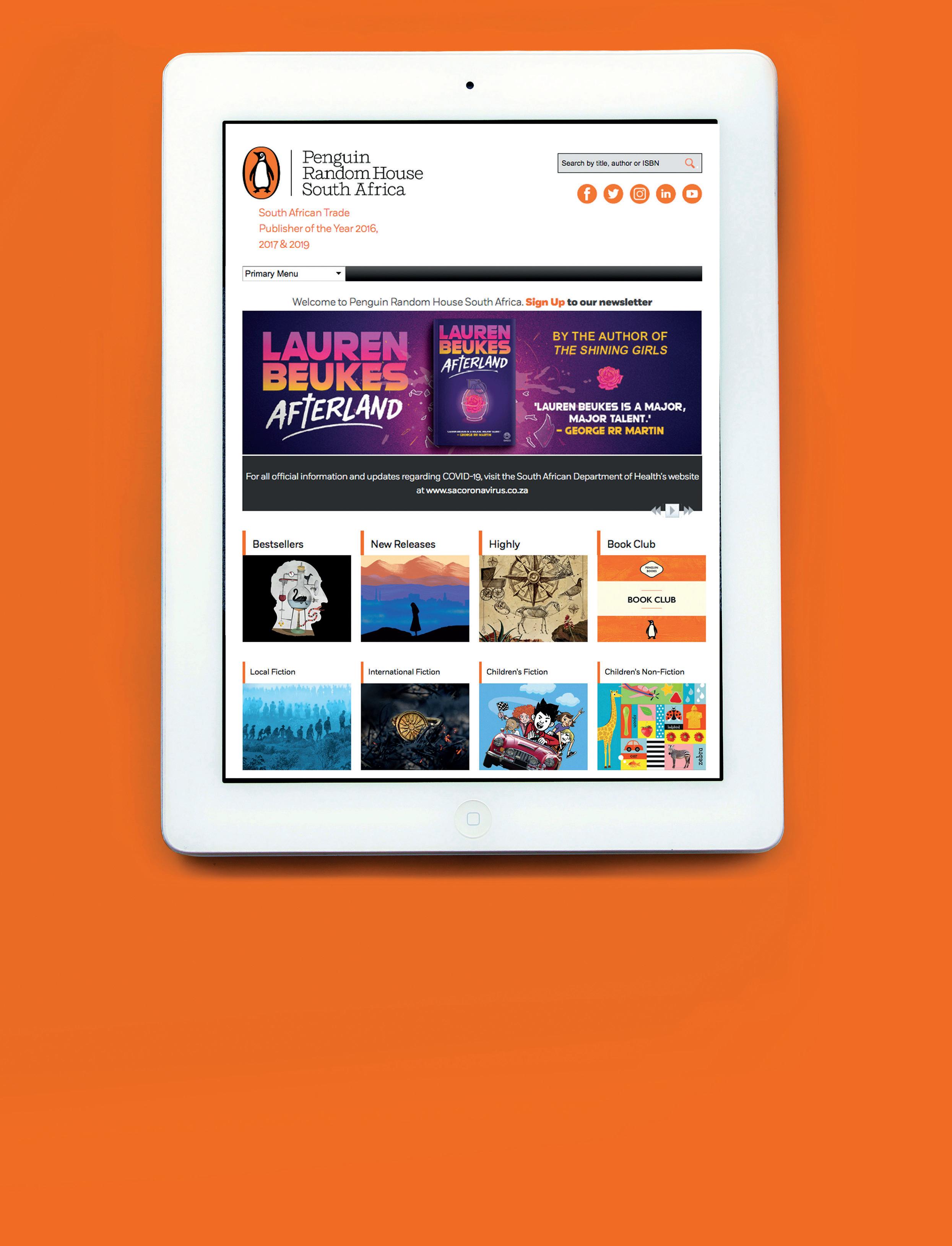THE PENGUIN POST
THE MAGAZINE ABOUT BOOKS FOR BOOK LOVERS
LESLEY PEARSE
“Inspiration is all around us”

BIG YEAR FOR BIRDERS
Sasol Birds 5 takes flight
CELEBRATE

“Inspiration is all around us”

BIG YEAR FOR BIRDERS
Sasol Birds 5 takes flight
CELEBRATE
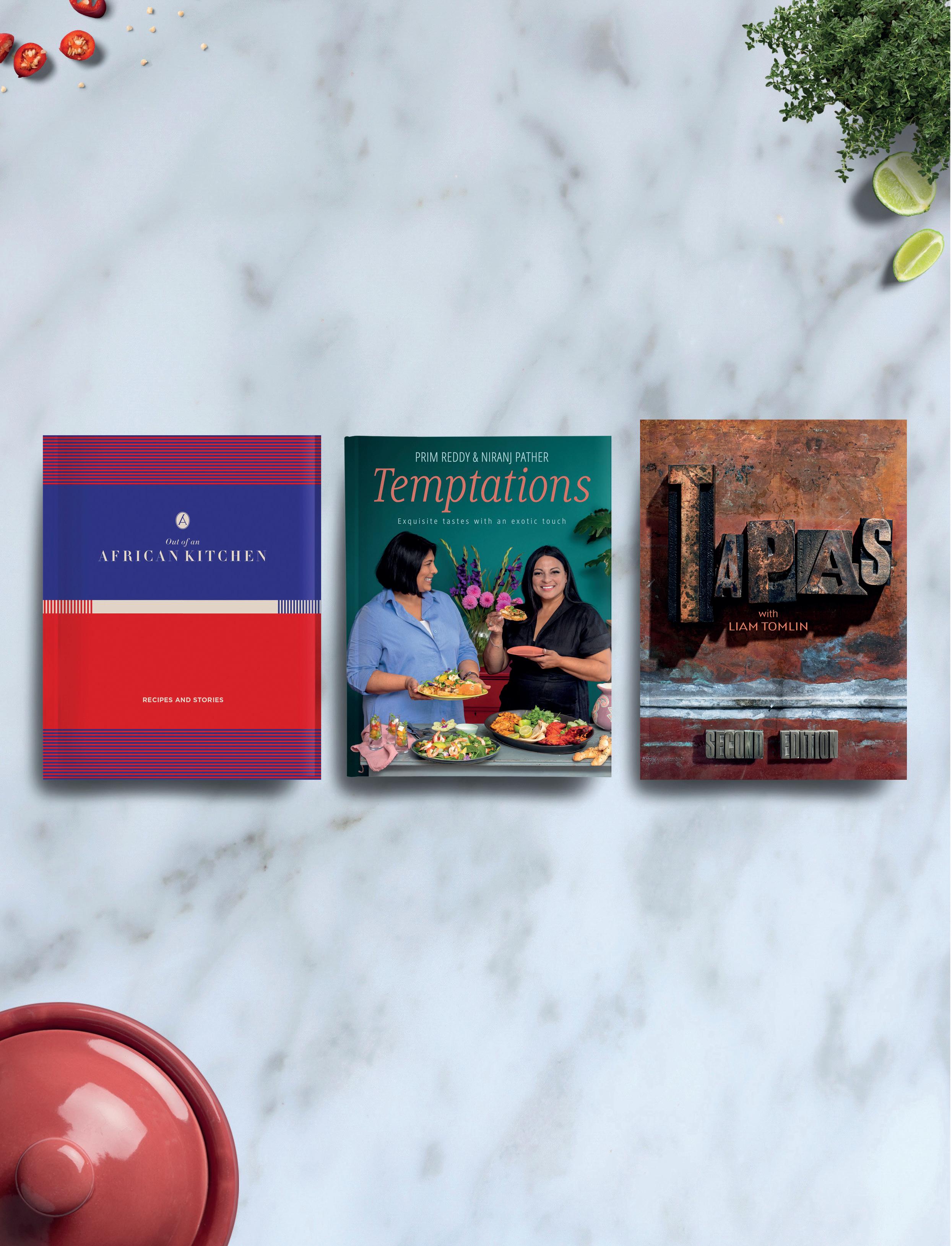
A collection of recipes from the Angama kitchen accompanied by stories, legends, observations, quotes, quirky facts and culinary acknowledgements that bring these dishes, the chefs, the lodge, the Maasai Mara and Kenyan food to life.
‘The recipes in this book are special to us and transport us into a world where every ingredient is an instrument in a food symphony. These recipes take us back to a time when life was simple and food brought us together, when the idea was to make easy meals in the shortest possible time so that everyone could celebrate as one.’ – Prim and Niranj
Tapas with Liam Tomlin is about the style of food that Liam likes to cook and the way he likes to eat, with lots of different tastes, textures and cooking styles. Indulge in a mouth-watering assortment of over 70 tapas dishes for easy entertaining, plus over 70 basic recipes for a professional result.
04 COVER Author
Lesley Pearse talks to us about where she gets her inspiration from

02 BOOKSCAPE The latest in books
07 AT MY DESK Hilary Prendini-Toffoli on her writing
08 INSIDER Q&A with The Boy, The Mole, The Fox and The Horse author, Charlie Mackesy
09 SPECIAL A tribute in books to Nelson Mandela
12 ADVICE Douglas Kruger talks business
13 HEALTH & WELLBEING
Ever thought of using cannabis as medicine? Author Kelly McQue weighs in
14
EXTRACT from The Land Wars by John Laband
16
FOOD Prim Reddy and Niranj Pather tempt us with three delish recipes from their new cookbook
19 RECIPE All aboard the tapas train with Liam Tomlin
20 IN MY OPINION
Natasha Freeman, author of new book on social movement, #I’mStaying

10 NATURE
SASOL Birds returns south this winter
Johannesburg | Rosebank Office Park, Block D, 181 Jan Smuts Avenue, Parktown North, 2193 | 011 327 3550
Cape Town | Estuaries No 4, Oxbow Crescent, Century Avenue, Century City, 7441 | 021 460 5400
© Copyright Penguin Random House South Africa (Pty) Ltd. The Penguin Post is published by Penguin Random House South Africa. All rights reserved. Reproduction without the written permission of the editor is strictly forbidden.
…to the very first issue of The Penguin Post. A magazine born from this brave new world we find ourselves in. It is our way of sticking to our commitment of providing you with the very best from our world-class list of books.
With access to brilliant authors locally and abroad, we’re able to give you, dear reader, juicy titbits from interviews with your favourite authors, such as Lesley Pearse, our delightful cover star for this issue, and Charlie Mackesy, artist and author of the touching book, The Boy, The Mole, The Fox and The Horse
Our huge panel of experts on topics such as health, wellbeing and business will weigh in each month with useful advice, and you’ll get inside info from some of our hottest releases, like the latest edition of SASOL Birds. We’ve been waiting in anticipation for this one, and we are not disappointed – it’s met all expectations, with truly stunning illustrations to boot.
And let’s not forget the food… mouthwatering recipes to satisfy even the most discerning taste buds. Try Prim Reddy’s butterbean and potato curry on page 17.
It is our great pride to bring you this first issue, and we hope that with each edition, we slowly work our way to the top of your reading pile.
As the mole said to the boy, “One of our greatest freedoms is how we react to things,” so, onward and upward!
Lauren
Lauren Mc Diarmid ThePost@penguinrandomhouse.co.za

The latest novel by award-winning Lauren Beukes takes a prescient look into how a virus changed a world forever. It is the year 2023, two years after a virus wiped out almost all men on the planet. Less than 1% of the population is immune to the disease. This includes Cole’s son, Miles. Locked up in quarantine, the two of them escape and set off on a road trip across America. They are trying to get back to South Africa, Cole believing that Miles – a hot commodity when it comes to the future of humankind – will only be safe once back home.
Scarily, Beukes describes the madness during the onset of the virus, with toilet paper and hand sanitizer in constant shortage at the shops; the uncertainty and hysteria that played out online; and conflicting reports, conspiracy theories, wrong information. Sound familiar? We wonder if Beukes has her own crystal ball tucked away somewhere…
Afterland is out now at leading bookstores nationwide and online, and is also available as e-book
With the Black Lives Matter movement taking hold of societies across the world, How to be an Antiracist by Ibram X. Kendi could not be more relevant. According to Kendi, It’s not enough being “not racist”; we have to be antiracist. In other words, neutrality is not an option: until we become part of the solution, we can only be part of the problem. A courageous leap by Kendi into building from the ground up a vital new understanding of racism.
‘To understand race relations today, we must push against our conditioning and grapple with how and why racial group memberships matter.’
Robin Diangelo, author of White Fragility
10 July
The thrilling Don’t Turn Around by Jessica Barry hits shelves.

16 July
Madelein Rust se sewende misdaadroman, My Naam is Legio, is nou beskikbaar.
You don’t want to miss out this month Ever wondered what’s behind one of the biggest selling authors in the world? We broke it down. the number of times his first book was rejected by publishers
28 July
The international launch of Rachel Joyce’s latest novel, Miss Benson's Beetle.
Visit our Facebook page for more events @PenguinRandomHouseSA
31 James Patterson in numbers
320 million
270 the amount of books written under his name is how many of his books have been sold
1 out of every 17 hardcovers sold account for Patterson’s novels in the US the number of books he’s donated to schoolkids and the military
3 million



minute with Abbie Greaves
We caught up with author Abbie Greaves to find out what she gets up to when she isn’t at her writing desk.
What are your hobbies?
Anything that calms the mind of a raging catastrophist – yoga, walking anywhere with no signal, reality television.
What or who inspires you?
Country music! I am an incurable romantic and have a ceaseless appetite for it. Probably not very fashionable but, in another life, I would be a Nashville lyricist. Musicians like Keith Urban and Carrie Underwood write the sort of songs you can bleed your heart out to – particularly interesting to someone who has written a love story.
What type of films do you love most?
Nicholas Sparks films. In my eyes, there are few things better than a tragic love story with a redemptive ending and he is the master.
Where did the idea for The Silent Treatment come from?
I read a newspaper article about a Japanese man who had not spoken to his wife for 20 years, and I couldn’t get the concept out of my head. The couple’s 18-year-old son had never seen his parents speak and asked a TV crew to stage a reunion. Reports suggested that their efforts were successful. Little, however, was made of the trauma that the silent treatment so often entails, so I wanted to explore that.
Abbie Greaves’ debut novel, The Silent Treatment, is out now
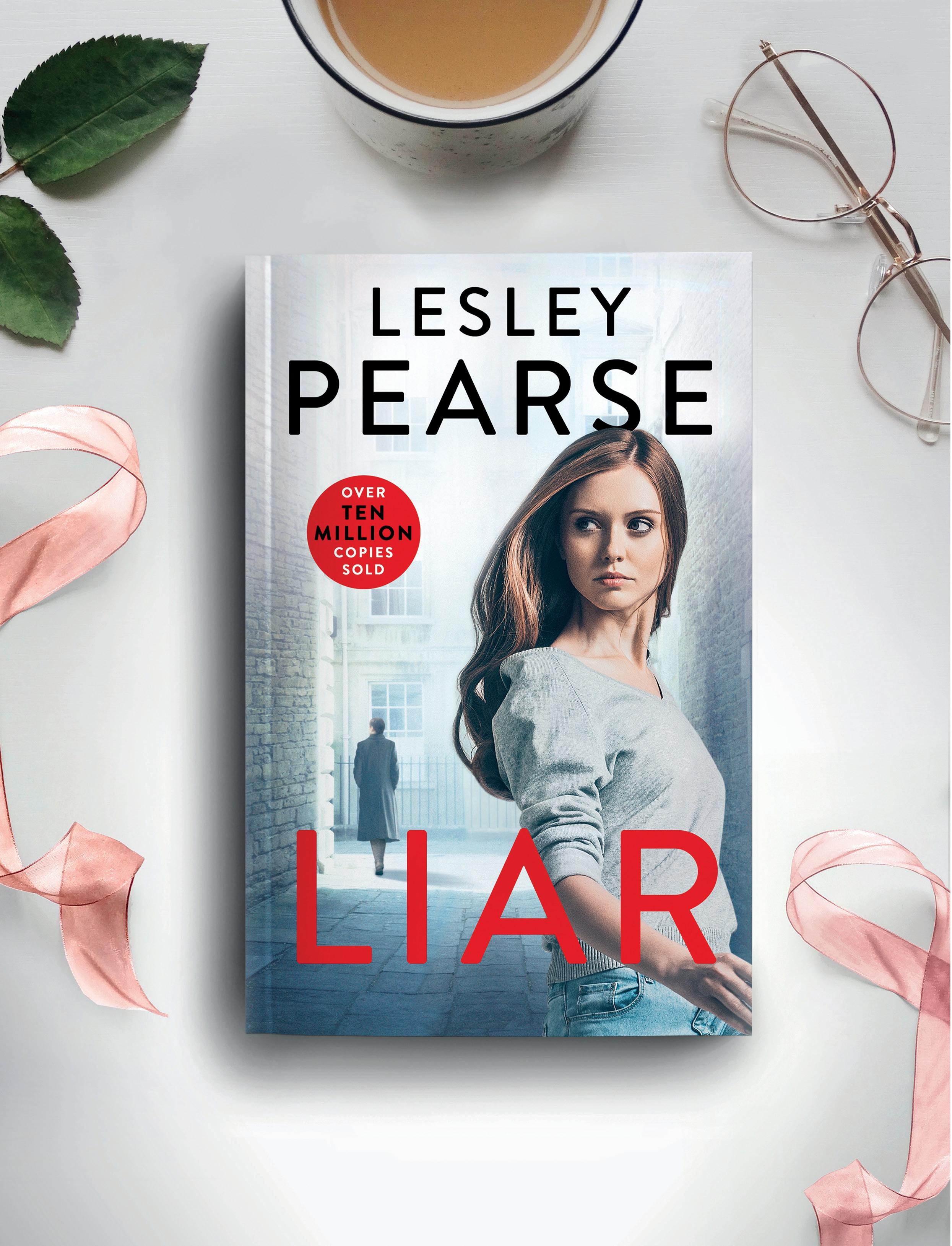
Internationally bestselling author Lesley Pearse chats to Lauren Mc Diarmid about where she draws inspiration for her books, from strolls along the beach front to her eight-foot giraffe.
I’m so enthusiastic about books; I don’t know why the whole world isn’t. When I tell people about books I really like, I sometimes let the whole story slip out, and my friends will say to me, Well, I don’t need to bother with reading it now! Books will always give us something to talk about, and a delicious peek into other people’s lives.
Sometimes, if I enjoyed the story, but not the ending, I almost want to tweak it to how I think it should have gone. I tend to do the same with television series, even if they’re biographical! And as these little bits build up, they can take on a life of their own, and possibly even end up in one of my own books.
It’s during cold and rainy winter days that I’m able to put all else aside, and get cracking on the bulk of my writing. Of course, it’s never quite so straightforward as sitting down, and zoning in for hours at a time.
My own home is a rich source of inspiration, full of colour and bits and pieces I’ve collected along the years. What they might lack in artistic merit, they make up for with joy, like my pretend parrots sitting pretty in their cage, or my porcelain puppy pen holder.

Liar, the latest novel from Lesley Pearse, is out on 29 July
And if you go outside, you’ll find my eightfoot wooden giraffe. He just loves surprising unsuspecting guests.
The room I love the most is funnily enough my guest loo. With its bright yellow wall paper, burgeoning with zebras and wooden leopard resting on the window sill, its befitting of its title, the Serengeti Suite. It’s my absolute guilty pleasure, and my guests who see it for the first time often compare going in there to taking a trip to Africa!
Sometimes when I’m writing, my King Charles spaniel, Stan will give me a look that says, Well, you can always take me for a walk, and we’ll go down to the beachfront for a stroll. Other times, I might sit down to do some thinking around a character I’m stuck on, and end up having a nap. Then if it’s a particularly lovely day, my garden will seem to beckon me outside to prune the roses or trim back some unruly stems, and how can I refuse?
But every distraction holds its own bit of inspiration, like my seaside town during the buzzing tourist season, or my garden, which is the ideal space for daydreaming. Once, it was a simple pamphlet about a Cornish woman exiled to detention in Australia that inspired
my novel, Remember Me. So, I save it up, and pray for rain!
Real-life influence came into play with Liar as well. It’s set in London, in the same street I took my first daughter home to as a newborn. There was a rubbish strike, and the trash bags outside were piled metres high. I once joked that you could bury a body in there and no one would find it till they cleared it, and the idea stuck.
I loved working on a book set in the seventies, because I could remember everything. It was quite a gloomy time, actually. We’d have power cuts every afternoon, decimalisation came in. It was almost like the party of the sixties was over, and all we were left with was overloaded ashtrays and the smell of stale booze. But it
Real-life plays a huge part in what goes into my novels
was all part and parcel of it, so the story just went on from that.
My oldest friends will tell you that I’m very much the same person I was back then – still as down to earth as ever. Although they might also throw in that I’m just as mad now as I was then, which I won’t dispute too much.
But I like to think I’ve held on to a lot of my character because I lived a full life before my first novel, Georgia, was published in 1993, and it wasn’t always easy. I’d had broken marriages, lost a child and my business went bust. It all made me quite humble, which is something I’ve held onto. I don’t assume that life owes me anything, and I’m grateful for everything it’s given me. It’s also often what I draw on in my writing.
It’s no wonder why my publishers battle to fit my books into any one genre!
Dive into the backlist with some of her best
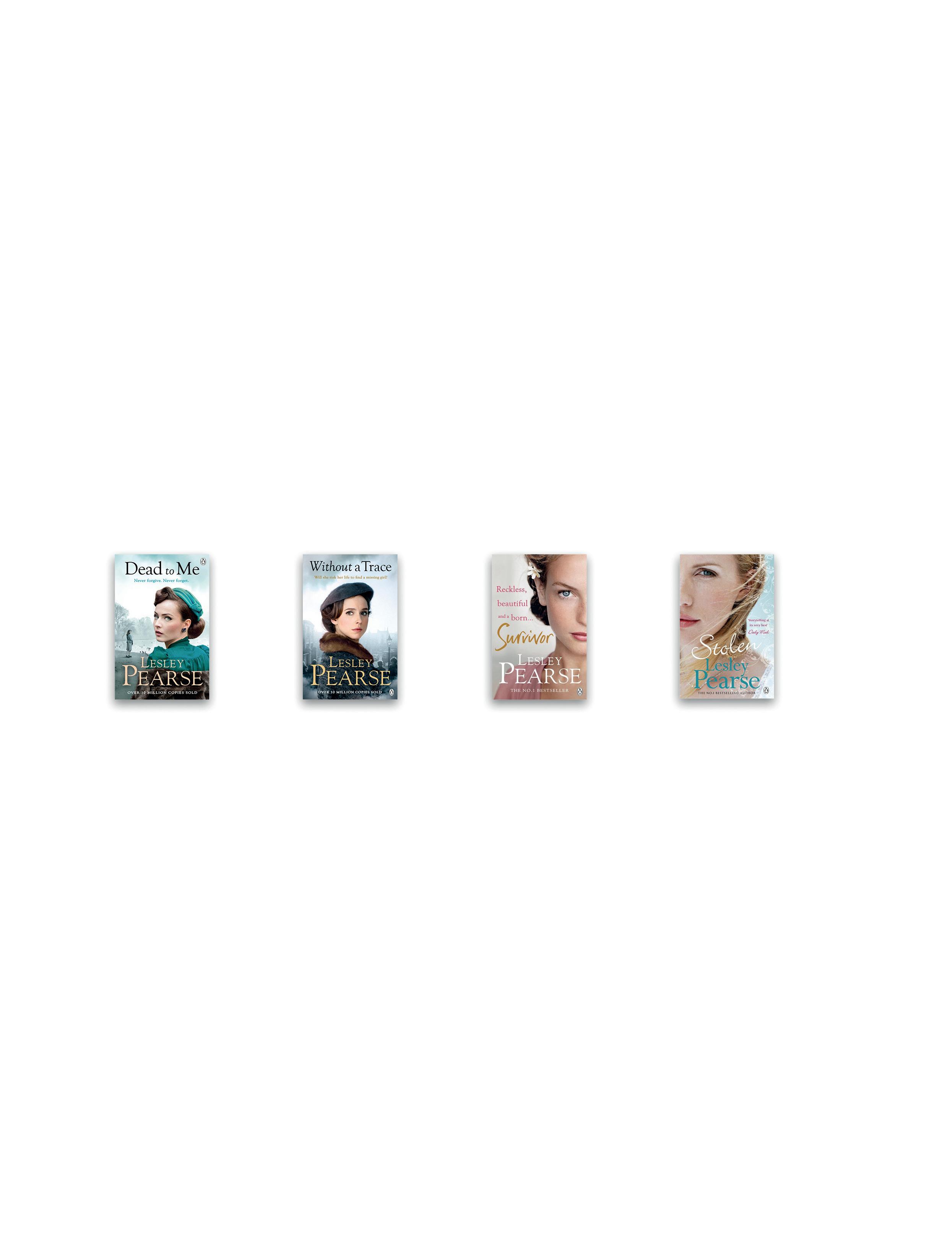
On London’s Hampstead Heath, two girls meet by chance: well-mannered and smartly dressed Verity and dishevelled and grubby Ruby. Somehow, the mismatched pair form an instant friendship strong enough to survive their parent’s disapproval. When war engulfs the country – sending Ruby to Devon while Verity struggles to find a new beginning under a shadow from her past – the girls are convinced they will always be there for each other. Until the day one breaks the other’s heart...
In 1953, Molly Heywood slips away from Coronation Day celebrations and makes a shocking discovery: her friend Cassie is dead and her six-yearold daughter Petal has vanished without a trace. The only clue is a letter from London, where Cassie once lived. Now it is up to Molly to head there and uncover the past that her friend kept so well hidden. The closer Molly gets to the truth, the more perilous her journey becomes.
It is 1938 and headstrong 18-year-old Mari Carrera leaves a gossipy small town in rural New Zealand for the bustling anonymity of London. She is all too willing to be seduced by the temptations of the glittering West End, until war comes and snatches it all away. As the Blitz rains death on London, Mari’s life is blown apart. Lost and alone, she learns that to endure this war she must find the strength, selflessness and compassion locked within her.
A beautiful young woman is discovered half-drowned on a beach. She’s wearing an old-fashioned dress and her hair has been hacked off. She’s obviously been bound by the wrists and ankles. But without knowing her own name or who did this to her, she can’t begin to piece together who she is and what led her to this unfamiliar place. The police are baffled, but when the doctors examine her they make a shocking discovery: she has recently given birth.
Not all who have earned their stripes in journalism can also claim to be writers. But Hilary PrendiniToffoli, doyenne of the South African magazine world, makes the transition seem effortless with her debut Loves & Miracles of Pistola.
I’ve been writing stories for years, since I was a teenager, so I don’t need motivation to sit down and start. I easily get into my characters and their story. I sit at my computer on the desk in my little office and go totally into their world.
My housemates in my twenties were always amazed at how I could sit tapping away at my Smith Corona in the kitchen – it was a small house in Mowbray – writing while they carried on around me.
I try to write every day after I’ve done some yoga and taken Josie, our black Belgian collie, for a walk. I’ve lived in different parts of the world and spent years as a journalist so I have enough experiences and intriguing characters in my head to draw on. Perhaps even subconsciously. Words just flow out. I get so engrossed that when my husband asks, “Are you going to have this salad or not?” I realise I have to take a break.
The characters of Pistola and his grandfather Nonno Mario first popped into my mind during the long stretches of an Eastern Cape road trip. I’d wanted to write about my husband’s life growing up in a tiny post-war northern Italian village, and this was a way to do it.
At first the story revolved around food and its importance in this place where the daily greeting is, “So have you had a good meal?” Then I remembered the piece I’d written for Style magazine on the young Italians brought to South Africa in the fifties as train stewards. I’d got great anecdotes from several who were still here running restaurants.
So I put Pistola into this historic story. It was fascinating. As Stephen King says “Put interesting characters into interesting situations and see what happens.”
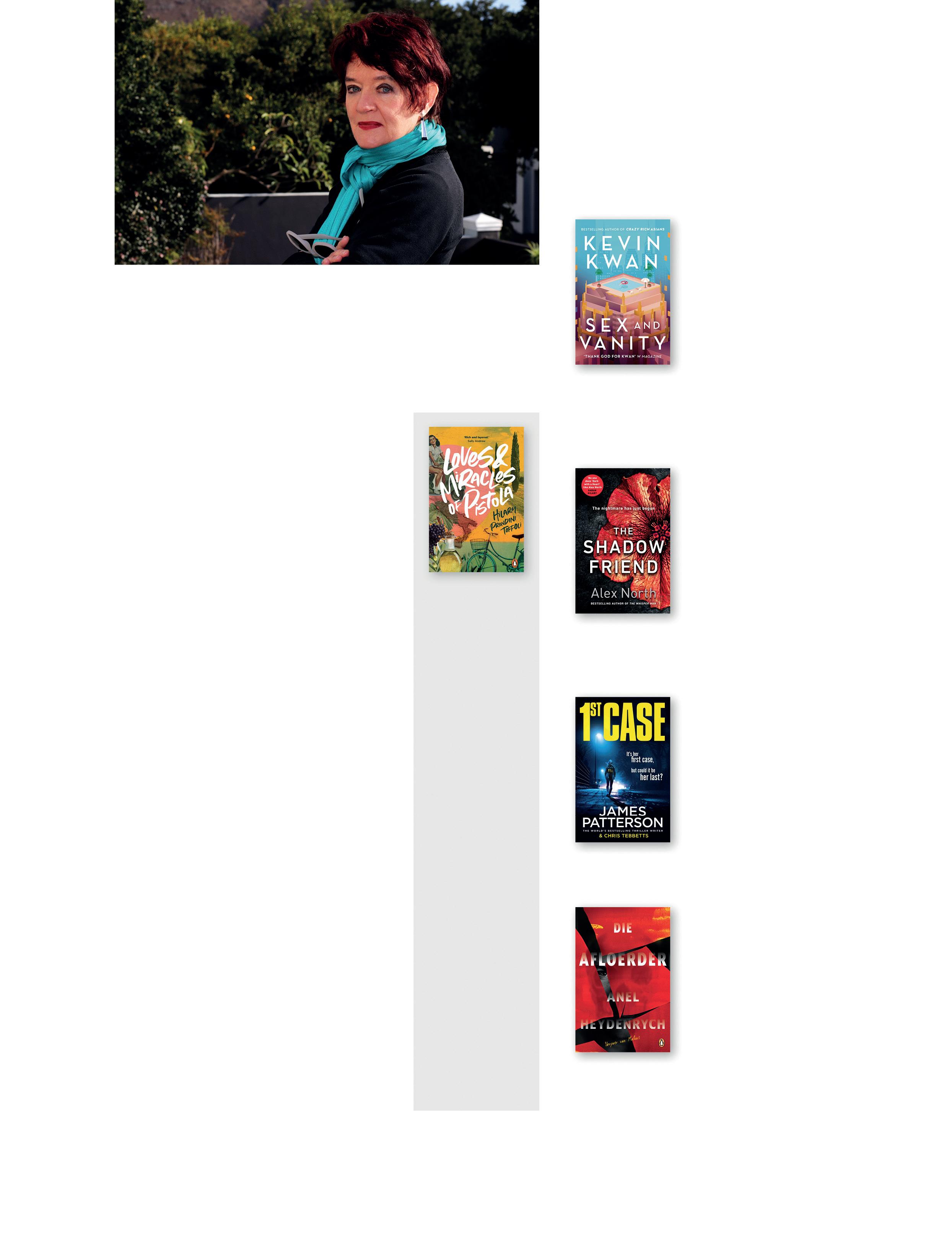
The young Pistola finds that his tiny Italian hometown is too small to share with the girl of his dreams – and her fiancé – and he decides to travel to South Africa to work as a steward on the trains. With a group of compatriots, he is trained in the lively 1950s Johannesburg. Living in Hillbrow, partying in Sophiatown and eventually losing his heart to a political activist. A vivid coming-ofage novel, filled with wit, affection – and pasta!
Cities 01: Sex & Vanity by Kevin Kwan
Moving between summer playgrounds of privilege, peppered with decadent food and extravagant fashion, Sex and Vanity is a truly modern love story, a daring homage to A Room with a View, and a brilliantly funny comedy of manners set between two cultures.
The Shadow Friend by Alex North Charlie Crabtree committed a shocking and unprovoked murder. Paul Adams, a friend of the victim, can remember the case too. For him the most unsettling wasn’t the murder, but that afterwards, Charlie was never seen again. A gripping psychological thriller.
1st Case by James Patterson
Angela Hoot has been offered a dream internship with the FBI. She jumps at the chance, and is thrown straight into her first case at a house in the Boston suburbs where a family of five have been brutally murdered.
Die Afloerder deur Anel Heydenrych
Johannesburgse joernalis Anje Bruwer soek rustigheid in die Karoo. Gou-gou word sy deur ’n reeksmoordenaar se siek speletjie met die polisie ingetrek. Omstandighede dwing Anje en kaptein Siegfried Scholtz om nou saam te werk wyl beide karakters sukkel met verhoudings tuis.
The work of artist and author Charlie Mackesy has been shared millions of times online, and his inspirational characters have been recreated by children in schools and hung on hospital walls. Here, he tells us more about his four unlikely friends who have captured the hearts of readers all over the world.

How did you get started in art?
I have always drawn – I was drawing horses when I was six. It was never a career option, and it’s never on the smorgasbord of choice at school is it? Either you’re going to be a lawyer, or a doctor, or a teacher, but you’re never going to be an artist. I still don’t think I’m an artist; I still think every day I’ll have to start a proper job tomorrow. But I got started in earnest after my best friend Jamie was killed when I was 18. It became a kind of therapy, and I haven’t stopped since.
When did you start doing The Boy, the Horse, the Fox, and the Mole drawings, and what inspired them?
Probably about three years ago. At the time, I’d just finished illustrating a book, where I’d gone back into working with ink and watercolour, after making sculptures and big surly rough things. So I played around with it a bit, and slowly they emerged as I was drawing. Then a vague narrative happened around them, from some questions I had in mind at the time about life and existence, which I decided to put into conversation. They were generally questions we don’t necessarily talk about - what’s the point of life? Why are we here? What do you think success is? I thought if I got run over tomorrow what I would like to say? So I made the book. What parts of you, and all of us, does each animal represent?
The boy represents the bit of me that wants to know why we’re alive and what we’re meant to be doing and doesn’t really know much. The
The Boy, the Mole, the Fox and the Horse is available now
mole is me, always hungry; always want to eat stuff; think I’m clever, but I’m not; think I’m wise, but I’m not. The fox is how I suppose we all are: hurt in some way. It’s the bit of me that’s quite withdrawn; fearful of trusting. The horse is the bit of me that is the slightly wiser, spiritual side of us, but also vulnerable; a side to most people, I think. So they all represent different parts of us, or me.
What is it about your work that you feel resonates with people?
It’s possible that it helps people remember what it’s like to be a child. An escape to a more simple time, from a world that is complicated and quite frightening. Politically and environmentally we are in a very precarious place, and fear and uncertainty are louder than they have been in a long time. But ultimately I think that’s a question for the reader to answer.
Are you trying to tell the readers something about love?
Maybe that love is just as important and just as successful, even more successful, than any other kind of success. We live in a world obsessed with achieving and often, if you list people’s achievements, it’s very rare that someone says, “I’ve kept good friendships and I’ve been faithful”. It’s more like “I earned a million dollars” or “I bought a big house”. That’s fine, but to me, it’s a greater achievement to love and be kind.
For more from this interview, go to Penguin Online.
If you’re looking for inspiration on what you can do to mirror the impact of our beloved Madiba this Nelson Mandela Day, 18 July, look no further than these great reads.

Moving, heartfelt, gripping and always inspirational, The Prison Letters of Nelson Mandela edited by Sahm Venter, provides the most direct evidence that even under regulations, restrictions and isolation, Madiba maintained a positive mind-set. Nearly seven years into his imprisonment, he shares his thoughts on the power of positive thinking in one of his letters with his then wife Winnie: “Remember that hope is a powerful weapon even when all else is lost”.
Intimate and inspirational, Going to the Mountain: Life Lessons from my Grandfather, Nelson Mandela by Ndaba Mandela, is a powerful and moving testament about Nelson Mandela’s spirit of resilience, endurance and hope through the eyes of his grandson. This candid and unflinching story reveals the uplifting life lessons of a strong and generous character that refused to be broken down, even under the most trying circumstances.
Remember
that hope is a powerful weapon even when all else is lost.
Through his words and deeds Madiba has been embraced by the world as a symbol of courage, hope and reconciliation. In the Words of Nelson Mandela edited by Jennifer Crwys-Williams, his comments on subjects as diverse as humanity, racism, friendship, oppression and freedom provide insight into the man and all he stands for. In turn moving, generous, humorous and sad, this book eloquently conveys his warmth and dignity. An endless inspiration for all who read it.
Written by the co-author of Madiba’s well-known autobiography, Long Walk to Freedom, Nelson Mandela: Portrait of an Extraordinary Man by Richard Stengel presents 15 powerful lessons on life and leadership based on the life and work of Nelson Mandela. This inspirational book with Madiba’s insights on love, leadership, courage, seeing the good in others and knowing when to quit challenges us to look within to improve our lives and to think about the legacy we leave behind.
How will you make a difference this Madiba Day? Tell us on Twitter, @PenguinBooksSA
The first edition of Sasol Birds of Southern African was published in 1993 to great acclaim, and the book quickly became the best-selling bird field guide for the region. Now in the latest fifth edition, the collective input by the authors, artists and the publishing team has significantly raised the bar on this enduring field guide.
Alarge part of the success of the first edition lay in the highly detailed artwork and the great number of plumages included in the form of males, females and, where relevant in-flight images too. The book’s claim to being the most comprehensively illustrated field guide to the region’s birds was entirely true. It became a landmark publication and a most soughtafter field guide for bird ID in SA. With Sasol as sponsors – allowing for the purchase of artwork from two highly accomplished British bird artists – the name Sasol Birds took hold and has persisted ever since.
Twenty seven years later sees the release of the new fifth edition of this guide, still generously supported by Sasol, and this time with two new authors on the team, two new artists and some considerable improvements.
COMING SOON
SASOL The Larger Illustrated Guide to Birds of Southern Africa will be available in August
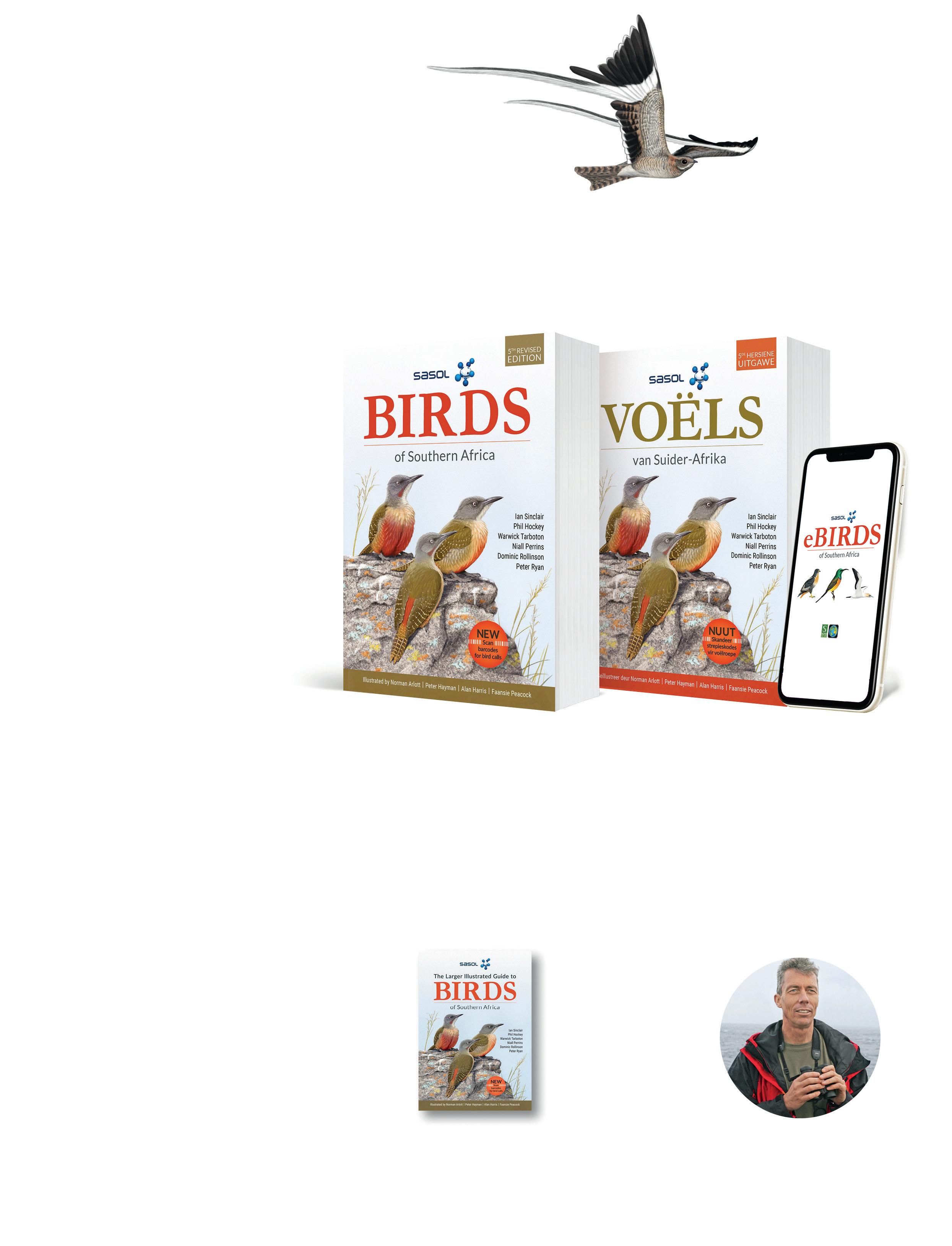
“It was almost 20 years after I was asked to work on the first edition that I was finally able to join the team, working on the fourth. This edition sees new authors join the team, bringing new insights and field experience. Perhaps even more exciting is the addition of so much new artwork. As a seabird aficionado, I can confidently say that Faansie Peacock’s albatrosses and petrels set a new standard for illustrations of these magical birds, and Alan Harris’s raptors will definitely help birders identify birds from these tricky groups. With the addition of the new sound recordings there’s much to enjoy in this revamped edition.”
Peter Ryan, Senior Author
“One of the most satisfying things about working on this latest edition was the brief given to us to prepare a wish list of all the things we thought would make this edition better than the last –and then to have that wish list manifest! Replace the seabird plates, the raptor plates, the nightjars, the ugly African Swamphen – done. Redo the pratincoles and coursers; tweak this bird’s posture – done. Bring in new blood, new ideas – done! A thousand new illustrations and two new co-authors later, it seems that no expense has been spared in making this the best-ever SASOL, as up-to-date as it can be, to the extent that it has included – done at the eleventh-hour mind you – three very recently separated francolin species. And on top of all

WHAT’S NEW
this, to have a direct link to the bird calls just a smart-phone away. And yet it remains the same comfortable, familiar, user-friendly fieldguide that it has been over the past 27 years. I am indeed proud to be associated with it.”
Warwick Tarboton, Senior Author
“I’ve been involved with Sasol Birds since joining the original team nearly 30 years ago. Even then, it was obvious we had a winner on our hands, and with each new edition, the guide has gone from strength to strength as the go-to for bird identification in Southern Africa. This latest exciting edition is no exception.”
Norman Arlott, Senior Illustrator
NEW! Scan barcodes using your smart phone and play bird calls using the free downloadable call app.
Comprehensive coverage of southern Africa’s birds, including latest species records.
Breeding bars, up-to-date distribution maps, and illustrations with labels showing diagnostic features.
Sasol eBirds has long been a best-selling birding app for southern Africa. Accessible and easy-to-use, the new and improved Sasol eBirds Southern Africa app will enhance your birdwatching experience without having to carry extra weight in your pack.
· Includes 989 bird species in line with latest taxonomical changes
· Updated information with fresh input from new contributing authors
· All species text in English and Afrikaans!
· Over 1 000 bird calls (previously 630+)
· Over 2 700 photos. No in-app purchase necessary
· New illustrations with finer attention to detail than ever before
· All new maps updated with latest known ranges
How smart businesses can make themselves ‘poverty proof’ in 2020 and beyond.
'Start by deciding what not to do…’
This was the opening chapter title in the new South African book published around the world, Virus-Proof Your Small Business
Designed to help entrepreneurs find creative ways to earn during lockdown, it was written in record time by business and wealth expert Douglas Kruger. Douglas is the bestselling author of Poverty Proof, Is Your Thinking Keeping You Poor? and Own Your Industry.
Since Virus-Proof Your Small Business appeared on bookshelves and online audiobook platforms from as far afield as Romania, New Zealand and Canada, Douglas has spoken virtually on the topic several hundred times. Here, Douglas shares his insight on the ideas he’s seen gaining the most traction.
Make the sale now. Deliver later
All wealth originates at the point-of-sale. And therein lies a useful principle. Even if you can’t carry out your process, point-of-sale may be separated in time from delivery, which means generating income remains possible. Take the example of boutique wineries in Cape Town selling on promise to buyers in Europe, who will collect later in the year, or the doggrooming service operating out of a van, and selling vouchers to neighbourhood pet-owners with a promise to snip once it’s permitted.
One of the most radical ideas for business innovation is also the simplest. If you cannot do what you do, then forget what you do. Ask only: What do my customers need right now? They may not be able to book or buy the thing you previously offered, due to the effects of extended lockdown. But they still exist. They
When everything hits rock bottom, a handful of canny builders, buyers and investors –those who choose to bravely expand even as others shrink – may ultimately become very wealthy.

Poverty
Proof For Entrepreneurs is available now
still have needs – just different ones. How could you serve the same people right now, even if in a completely different way? It may be only for a time, and doing so helps you to remain relevant to your base.
Position yourself as the leading choice for when business does return
Could you use this ambiguous, tumultuous time to position yourself as the industry leader? That might mean buying up competitors who are now exiting the game. It might mean writing the book, or producing the online show, that makes you a household name. It could entail something as simple as writing useful articles for your customers on how they can negotiate the downturn. The more helpful, prominent and entertaining you are right now, the more you will become the name at the end of the sentence: ‘You know who you should talk to about that…?’
Douglas points out, we must keep our eyes on the fact that the human needs underpinning business have not disappeared. They have merely been placed on pause, and many will return in a tidal wave, having built up and dammed over time, like the need for haircuts.
Churn may be scary, but it also creates massive opportunities for the wily entrepreneur who is paying attention and acts quickly. Finally, Douglas points out that we must not forget that one of the most simple but effective wealth formulas is: Buy low, sell high
Meet Douglas at douglaskruger.com, and subscribe to his YouTube channel in which he gives daily tips on wealth.
Author of At Home with Cannabis, Kelly McQue goes into depth on how cannabis interacts with our bodies, how it makes us feel and what to do if you accidentally take too much.
Using cannabis is a very individual experience and unlike the pharmaceutical model, where the one-size-fits-all approach is used, cannabis requires a more personal approach when it comes to choosing the correct strain and dosage. Understanding how cannabis interacts with your body is important when choosing the correct cannabis treatment, and so is being informed and prepared for any possible side-effects, which although harmless, can feel frightening.
HOW DOES CANNABIS HEAL THE BODY?
Cannabis works holistically with the body, often bringing more than one issue at a time under control. The reason it is able to do this is because cannabis interacts with our body’s endocannabinoid system, a regulatory system which is present in all mammals.
Cannabinoid receptors are found throughout the body – they are present in the organs, brain, connective tissue, glands and even immune cells – and it’s this network of receptors that is responsible for regulating, for example, appetite, mood and pain.
Cannabinoids are a class of diverse chemical compounds found in plants, animals and humans which interact with the endocannabinoid receptors to regulate the abovementioned important bodily functions. Cannabis has over 85 different cannabinoids that interact with our endocannabinoid system. If you think of the endocannabinoid system as a set of locks, then the cannabinoids in cannabis are the keys that perfectly fit these locks and, together, they work to unlock the body’s full healing potential.
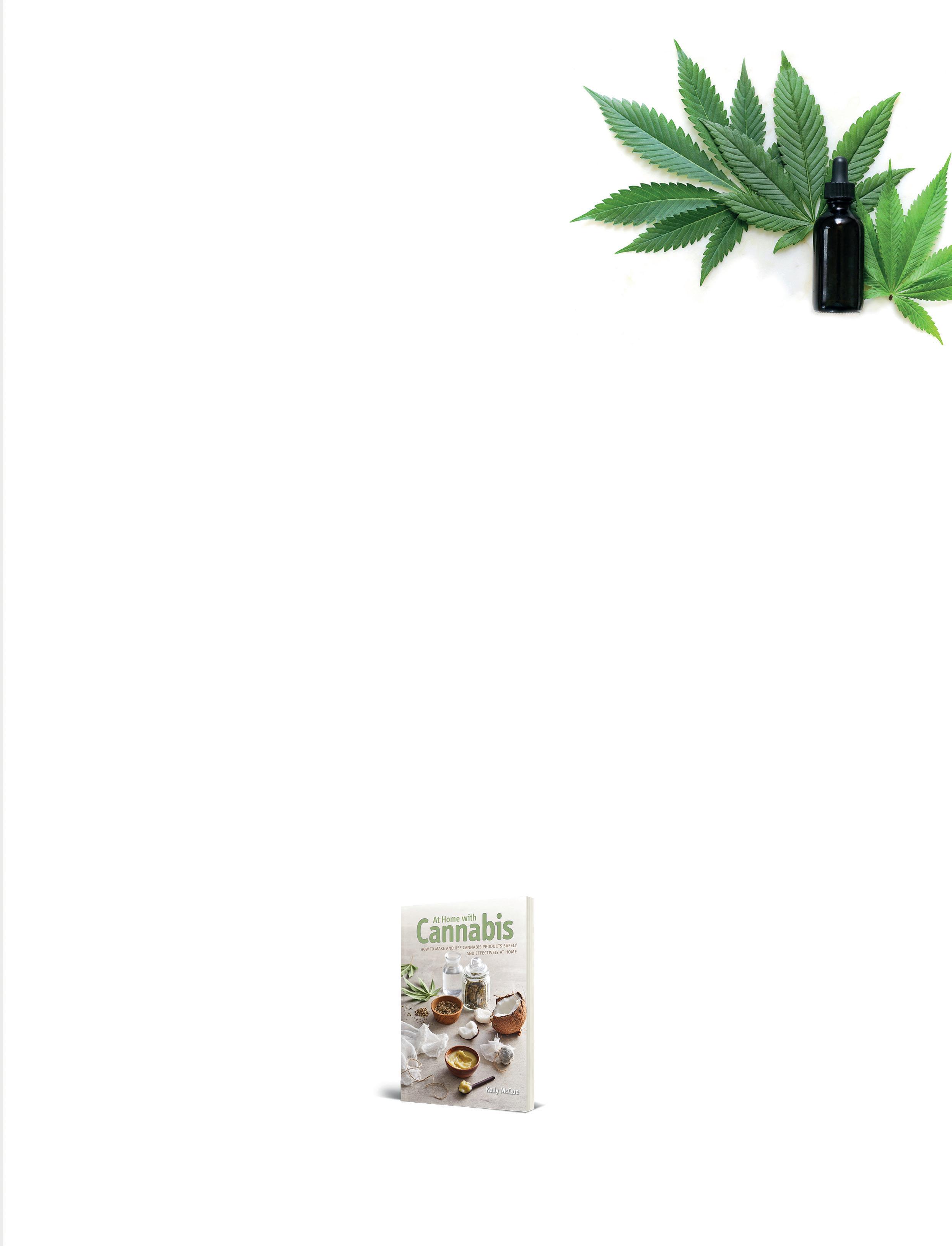
At Home with Cannabis is available now
Unless you have used cannabis extracts before, you will have no idea how high or low your personal tolerance is and for this reason I always recommend that you start on the smallest possible dose and work your way to a larger dose over time.
It is important to note that often, when using cannabis for the first time or when using it again after a long period of abstinence, it can have zero effect – no high, no side effects, nada.
This is because our cannabinoid receptors become dormant if they’re not used and so the first time you use cannabis these receptors are not yet open to receive the cannabinoids. That is not to say that it’s having no effect at all – the first time you use cannabis, your body will begin opening these pathways, making it possible for you to absorb the THC and CBD the next time.
So, if you are using cannabis for the first time and you don’t feel like anything is happening, remember that this is normal. Don’t double your dose the next night, thinking you didn’t take enough. Many people have made this mistake and it results in overdose, often referred to as ‘green fever’, which although not dangerous, can be very unpleasant. Do not increase your dose until the third night, and only if you feel you are ready.
Visit Penguin Online to find the recipe for a yummy immune-boosting Cannabisinfused honey.
An extract from the essential new read for South African history enthusiasts, from well-known Zulu historian John Laband.
The Sixth Cape Frontier War, 1834–1835 (the War of Maqoma, or of Hintsa) and the Coming of the AmaMfengu
In December 1834, Xhoxho, Maqoma’s favourite half-brother and effective ruler of the Ngqika section of the amaRharhabe, had his head slightly grazed by a shotgun blast during operations by a colonial patrol. The incident sparked widespread indignation among the people, who declared, ‘It is better that we die than be treated thus… Life is no use if they shoot our chiefs.’ Maqoma had been itching to take his revenge against the British who had driven him from his lands and continued to harass his people through the reprisal system. Yet he had been held back by his well-founded concern that his men were no military match for the aggressors. With the wounding of Xhoxho, he nevertheless resolved he could no longer endure the indignities the British continued to heap upon the amaRharhabe, and furiously declared that ‘the blood of a son of Ngqika has been shed and [can] only be avenged by blood!’ The harvest of 1834 promised to be an especially abundant one, so that summer
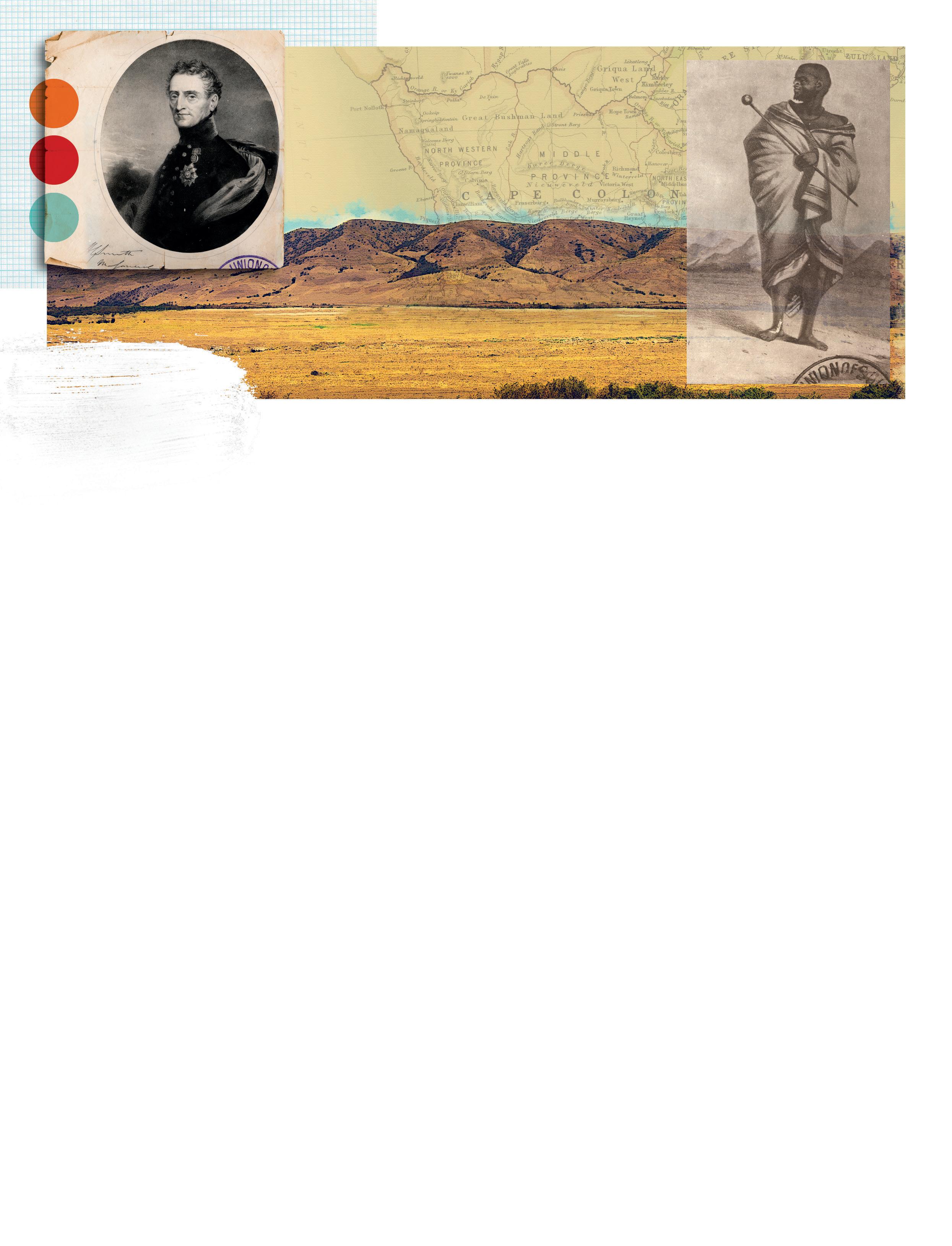
would be a propitious time to go to war. As regent of the amaRharhabe, Maqoma consulted the other Xhosa chiefs living between the Colony and the Kei River. The amaNdlambe, imiDange and amaMbalu fell in more or less enthusiastically with Maqoma’s call to arms.
On 21 December 1834 perhaps as many as 10 000 Xhosa fighters launched a series of raids into the Colony along a broad, 145-kilometre front from the Winterberg in the north to Algoa Bay in the south. This attack was the opening move in the Sixth Cape Frontier War of 1834–1835 and was exceptional in that it was the first time the amaXhosa had ever deliberately initiated major hostilities. The ensuing conflict, known to the amaXhosa either as Maqoma’s War, or as Hintsa’s War, would prove the most brutal and wide-ranging up to that time.
The amaXhosa advanced in numerous small detachments, evading CMR patrols and easily bypassing the chain of fortifications that the British had erected with such effort and expense at key points along the border, but which proved a useless deterrent when put to the test. Caught unprepared, the British garrisons abandoned some of their key forts, including the showpiece
Fort Willshire – where the trade fairs were held – which the amaXhosa proceeded to loot and burn, and retreated to Grahamstown and Fort Beaufort. With no forces in the field to oppose them, the amaXhosa rampaged through the border districts at will.
The entirely unanticipated Xhosa invasion of the Colony unleashed widespread panic and confusion in the Albany, Somerset and Uitenhage districts and inflicted considerable destruction and loss of property. Between 22 December 1834 and 12 January 1835, thirty-two settlers (their womenfolk and children were spared, as was the Xhosa custom in war) and about eighty of their Khoikhoi servants were reported killed, 456 farmhouses were besieged and burned down, 300 were pillaged and some 5 700 horses, 115 000 cattle and 162 000 sheep were driven off by the exalting amaXhosa. Thousands of colonists were reduced to destitution overnight. Only the missionaries were left unharmed, on the orders of the Xhosa chiefs. The amaXhosa had hoped that the Khoisan would rally to them, and some labourers and servants did indeed serve as guides to the raiding parties. But, encouraged by the missionaries, the Khoisan generally stood by the government, some took up arms in its cause, and others suffered at Xhosa hands. The terrified settlers close to the border took refuge in the frontier villages and settlements of Fort Beaufort, Grahamstown, Bathurst and Salem, where they built defensive barricades and fortified the stone churches. Further west, Boer farmers formed their traditional wagon laagers. One of them at the farm Mooi Meisiesfontien came under amaXhosa attack on eight successive nights. Disconcerted British officials, caught flatfooted and thrown onto the defensive – and only too aware that the Cape garrison had been reduced by almost 40 per cent since 1820 and now stood in the region of only 1 600 regular troops – were egged on by the shrilly panicked colonial press to portray the Xhosa incursions into the Colony as entirely unprovoked. Counter-measures had to be adopted with all despatch. Governor D’Urban, although he enjoyed a fine military reputation, was known to be slow and cautious. On this occasion, though, the moment news of the Xhosa invasion reached him on 28 December,

The Land Wars is available now
he had the good sense immediately to bundle off the dynamic Colonel Harry Smith to take temporary command of military operations on the eastern frontier until he himself arrived.
Henry George Wakelyn Smith (1787–1860) was the son of a provincial surgeon. He was excitable by nature, with an appalling temper, and was given to ferocious swearing. Still, his tremendous self-confidence and invincible optimism meant that he always inspired the men he commanded.
Smith possessed considerable military experience. During the assault on Badajoz on 7 April 1812 during the Peninsular War, he had rescued the ravishingly beautiful, fourteen-yearold noblewoman, Juana Maria de Los Dolores de Leon, from the horrific sack of the town. He subsequently married her, and she remained devoted to him, accompanying her paladin on most of his military campaigns thereafter. Smith fought in the War of 1812 against the United States, when he witnessed the burning of the White House in Washington, and was present on the field of Waterloo. However, as with many another officer, Colonel Smith’s chances of further promotion were severely diminished with the coming of peace, and in July 1828 he accepted the post of deputy quartermaster-general at the Cape. This was a distinctly unglamorous posting, but the Sixth Cape Frontier War gave Smith a fresh opportunity to shine.
Urgently despatched by D’Urban to stem the crisis on the eastern frontier, Smith famously rode from Cape Town to Grahamstown in a mere six days. There, to his contempt, he found chaos and confusion, with the settlers cowering behind their barricades, even though by the time he arrived on 6 January 1835 the amaXhosa were already retiring east of the Fish and Keiskamma with their enormous booty in livestock. This withdrawal was part of the Xhosa plan. For although ordinary Xhosa warriors exuberantly expected to drive the hated colonists into the sea, Maqoma and Tyhali understood they did not possess the means to do so. Their objective in raiding the Colony was strictly limited, confined to employing a sharp, destructive blow in order to induce the worsted British into a negotiating a settlement that would address their grievances. Of one thing they were certain: they had no intention of embarking on a prolonged, potentially disastrous campaign.

Niranj Pather and Prim Reddy embrace the diverse culinary offerings in cosmopolitan South Africa and their new cookbook, Temptations, reflects exactly that.
This is arguably one of my favourite soups. It’s rich, creamy and luxurious. Served with toasted bruschetta, it’s so delicious, you may choose to skip the main.
250 g button mushrooms, chopped salt
2 Tbsp salted butter
500 g deboned chicken breasts, chopped
4 cloves garlic, crushed
1 Tbsp flour
2 cups full-cream milk
4 cups fresh cream ground black pepper fresh basil for garnishing
Add the mushrooms to a heated saucepan with a pinch of salt. Once all the liquid has evaporated and the mushrooms start to toast, add 1 Tbsp of the butter, followed by the chicken and garlic. Cook until the chicken is completely opaque.
Melt the remaining butter in a mug in the microwave for 15 seconds, then mix in the flour and gradually add the milk, making sure there are no lumps. Add this to the saucepan and cook over low heat for 5 minutes.
Once the sauce starts to thicken, stir through the cream, and season with salt and black pepper. Serve garnished with fresh basil.
Butter beans in tomato sauce cooked in a delicious mild curry with the softest potatoes … yum! This may be a simple dish, but I can assure you that everyone will enjoy tucking in. Serve it in a bunny chow, over saffron rice or on its own. I like to eat it with a traditional carrot salad.
½ cup olive oil
4 cinnamon sticks
1 tsp cumin seeds
1 sprig fresh curry leaves
½ onion, sliced
1 heaped Tbsp mild curry powder
1½ tsp salt
4 medium potatoes, peeled and quartered
½ cup water
2 x 410 g tins butter beans in tomato sauce fresh coriander for garnishing
CARROT SALAD
2 large carrots, grated
½ onion, sliced
½ tsp salt
2 tsp lemon juice
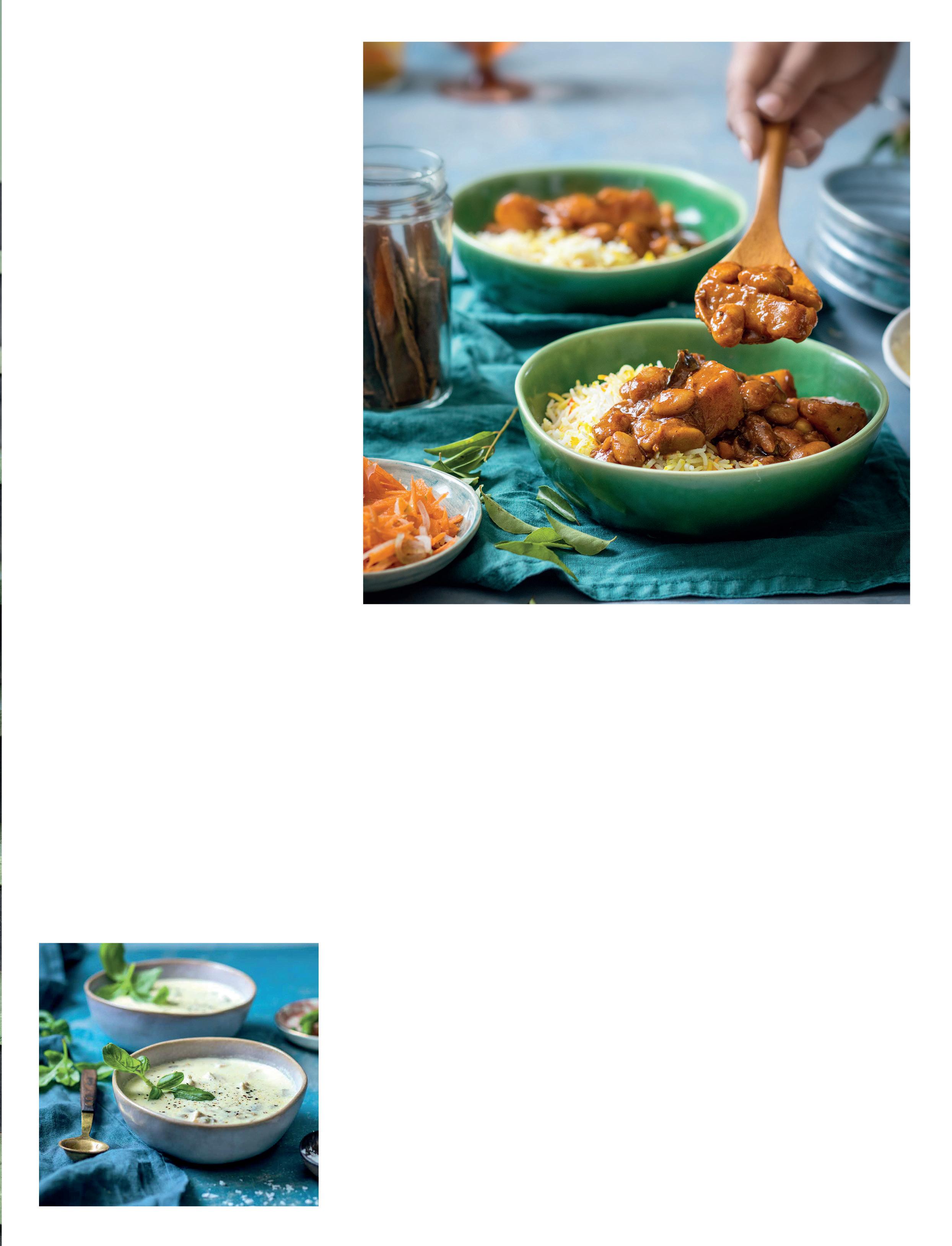
Heat the olive oil, cinnamon sticks, cumin seeds and curry leaves in a frying pan and fry the onion.
Once the onion has softened, add the curry powder, salt, potatoes and water.
Cook for 10 minutes or until the potatoes are semi-cooked, then add the butter beans and mix through.
Continue to cook for a further 10 minutes until the potatoes are soft and melting away.
To make the carrot salad, place all the ingredients in a bowl and mix well.
You can make these little pots of deliciousness up to two hours in advance. Once you’ve filled your cups or ramekins, cover them and chill in the fridge until ready to bake.
250 g butter
200 g dark chocolate (minimum 70% cocoa solids), broken into small pieces
¼ cup Tia Maria or dark rum
125 g golden castor sugar
4 extra-large whole eggs
2 large egg yolks
1 tsp vanilla extract
65 g cake flour, sifted
1 tsp ground cinnamon fresh raspberries and fresh mint for garnishing cocoa powder for dusting

Preheat the oven to 180 °C. Lightly grease 10 x 150 ml ovenproof coffee cups or ramekins.
Melt the butter and chocolate in a bowl set over a saucepan of gently simmering water, making sure the base of the bowl doesn’t touch the water. Once melted, remove from the heat, add the Tia Maria or dark rum and stir until smooth and glossy.
In the meantime, place the castor sugar, whole eggs, egg yolks and vanilla extract in the bowl of a stand mixer and whisk until the mixture has doubled in volume – this will take SERVES 10
about 10 minutes. The mixture should look like mousse and not be runny.
Pour the chocolate mixture into the egg mixture, then add the flour and cinnamon. Using a large metal spoon, gently fold everything together.
Divide the mixture between the greased cups or ramekins (you may find it easier to use a ladle) and place them on a baking tray.
Bake for 10–12 minutes until just firm at the edges, but still a little runny in the centre. Garnish with fresh raspberries and mint, dust with cocoa powder and serve.
If you fancy pairing this meal with a divine mulled wine, visit Penguin Online to download Niranj and Prim’s recipe.
Temptations is available now
International chef and restaurateur Liam
Tomlin is known for modern, artful dishes, inspired by seasonal ingredients. In Tapas, his latest offering to cookbook shelves, Tomlin swaps out stiff, formal meals for a more laidback eating experience.
1 kg floury potatoes, peeled and cut into paper-thin slices
1 onion, peeled and finely chopped
1 clove garlic, peeled and finely chopped
4 sprigs fresh thyme
1 litre olive oil
salt and freshly ground pepper
8 free-range eggs
100 g chorizo, sliced
Place the potatoes, onion, garlic and thyme in a heavy-based saucepan.
Cover with 950 ml of the olive oil and lightly season with salt and freshly ground pepper. Place over a medium heat until the oil just starts to warm, then reduce the heat to low and gently cook the potatoes until they are completely cooked and soft (30–35 minutes).
Place the potatoes into a chinois to drain the oil. The oil can be strained and used another two or three times.

Whisk the eggs and season lightly with salt and freshly ground pepper. Reserve 150 ml of the egg mixture in a separate bowl. Add the potatoes and chorizo to the remaining egg and gently mix so that the potatoes are evenly coated with egg.
Heat enough olive oil to cover the base of a 28 cm non-stick frying pan over a medium heat. Pour in the tortilla mix. As the mixture begins to set, shake the pan in a circular motion to ensure even cooking. Using a wooden spatula, shape the tortilla into a thick disc shape. Cook for a further 2 minutes, then cover the pan with a large, flat plate and flip the tortilla onto the plate. Gently slide the tortilla back into the pan, uncooked-side down, and reduce the heat to low.
Smooth out any imperfections on the cooked surface of the tortilla by pouring over a little of the reserved beaten egg and smoothing it with
a wooden spoon. Continue to cook for 2 minutes. Flip the tortilla again and repeat the smoothing process. Cover and cook for a further 2 minutes. Repeat the process again and cook for another 2 minutes.
When done, the tortilla should still have a little wobble in it when you gently shake the pan. Remove from the heat and keep in a warm place for 5 minutes. Transfer it onto a plate and cover with clingfilm for 5 minutes to allow the residual heat to set the remaining uncooked egg.
Serve the tortilla whole or cut into wedges. It is good served hot or at room temperature, but not chilled.
Want to try
Liam’s crisp vegetable salad or roast chicken with lemon and garlic? Then visit Penguin Online to download the recipes.
Author and communications specialist, Natasha M. Freeman, writes here about kindness and unity, and how the need for it led to the popular and powerful social movement, #I’mStaying. Her inspirational new book, of the same name, is out now.
The experience of being human is all at once, many things. We are born and explore our way through the world with childlike hands reaching forward, with eyes that see, thoughts and experiences that shape our perceptions and influence who we become (how we treat ourselves and others).
We are not born with words to describe these experiences, no alphabet, no phonetic, culturally relevant sounds. But we are not born without language. Between us, we exchange unspoken words and intentions, daily.
This unspoken language is bigger than our differences, than tribes, cultural heritage, age old tradition, political association, or geographical boundaries. It is a language that brings people together, inspires civil movements, and throughout history – not without suffering, emotional devastation, or tragedy – has inspired deep-seated collective courage, to bring about change.
In my experience, whether writing about religion, fear, racism, political systems aimed at demolishing human relationships – the subtleties of this common language continue with gently persistent hands to pull us forward through history.
It is a language of collective human longing against harm. It emerges as validation, dignity, and respect expressed through kindness. Empathy. As a species, we are hardwired to kindness, and we thrive in social communities that impart this authentic exchange, which repeatedly shows itself to be the foundation of our collective human moral compass.
It seems impossible that an unspoken language of kindness is powerful enough to
On the #I’mStaying Facebook page, South Africans have come together not to forget about the past, but to forge their own future.
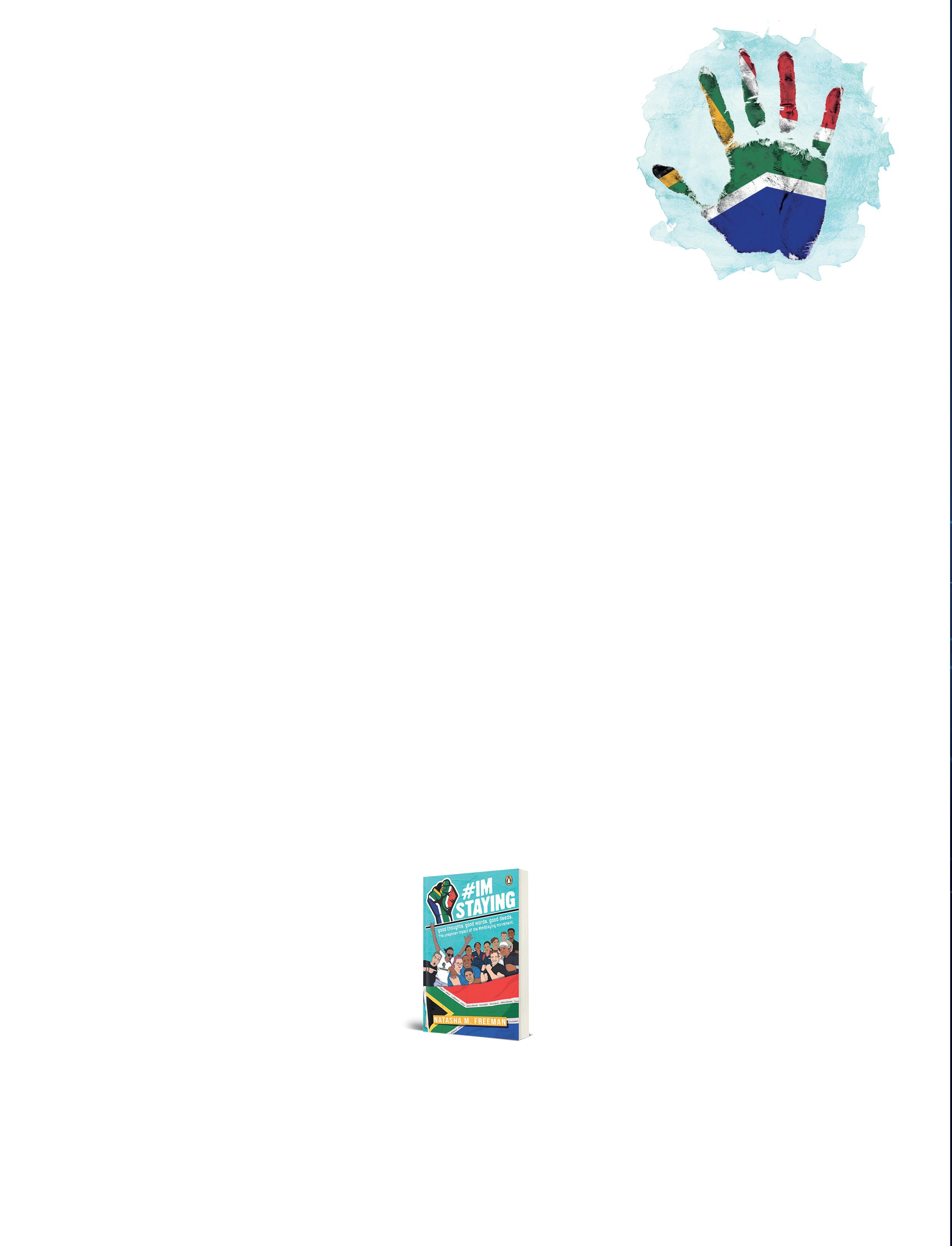
#ImStaying
by Natasha M. Freeman is available now
fuel change throughout history, but we find its presence everywhere: at the heart of silent protest or collectively bending one knee in support of a vision that includes each other.
It is this collective language of human unity – the longing and want for it – that gathered over a million South Africans to a Facebook page called #ImStaying.
The page has become a place of storytelling for South Africans looking to move beyond political realities that have traditionally defined their lives, South Africa herself, and South Africans in the eyes of the international community.
Through the stories of everyday South Africans, #ImStaying has become a look into the spaces between the politics, a look into the postapartheid, post-colonial lives of everyday people. Where, beyond political rhetoric and corruption, despite poverty, where beauty and simple acts of Ubuntu take place as a part of real life.
#ImStaying is the story of a South Africa who is more than her politics. She is her people. Bright, alive in her resilience, a gathering of treasures beneath many skins, sparkling and shining deep gold. Here, South Africans have come together not to forget about the past, but to forge their own future.
An outpouring of stories about people finding themselves, for the first time, in each other, using the power of an unspoken language to collectively lift the weight of history between them overhead, and carry it together to making room for the future. Where respect and dignity make space for simply being human, together.
Visit Penguin Online to read an extract.

Now available at leading bookstores nationwide, online and as e-books
